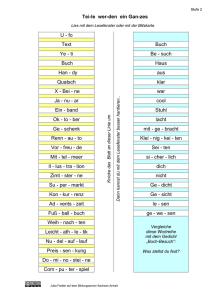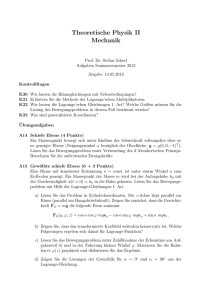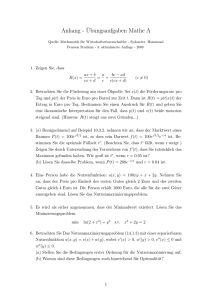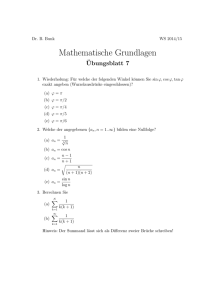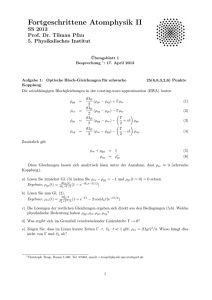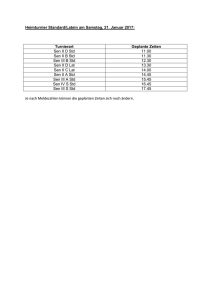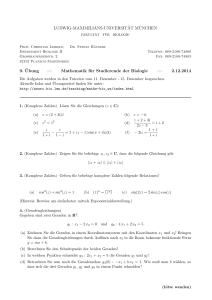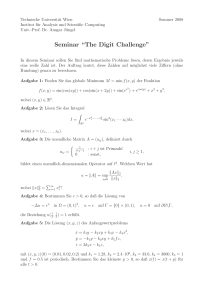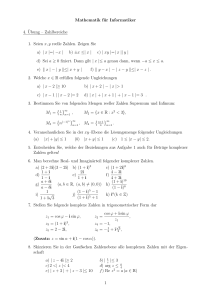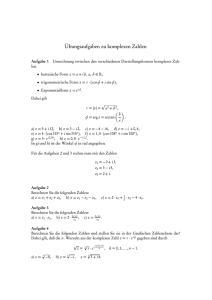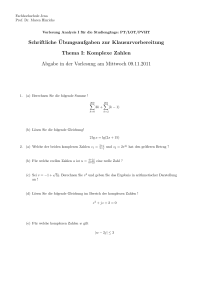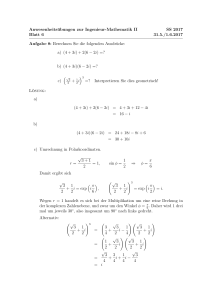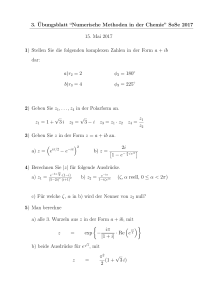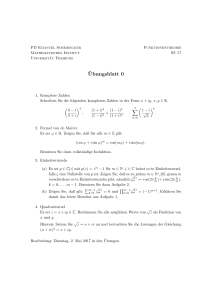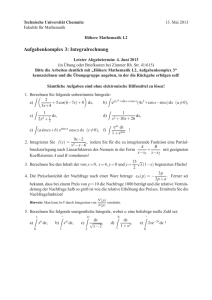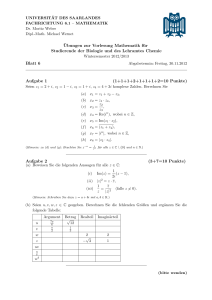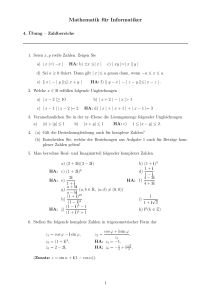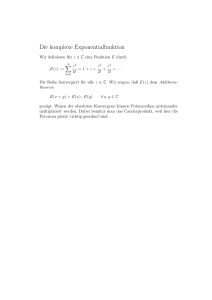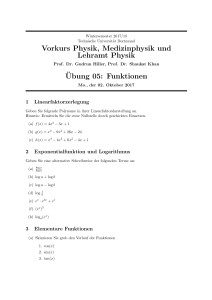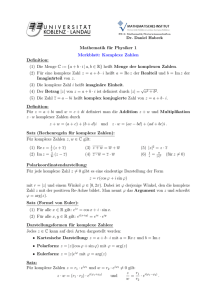Ubungen zum Kurs Gewöhnliche
Werbung
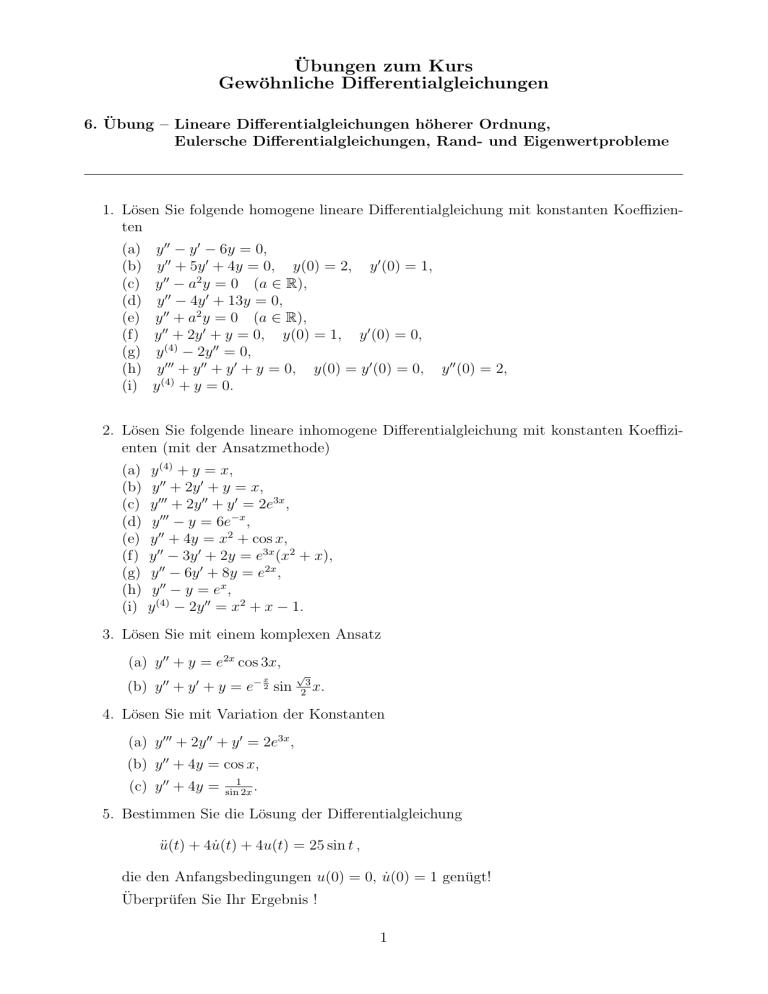
Übungen zum Kurs Gewöhnliche Differentialgleichungen 6. Übung – Lineare Differentialgleichungen höherer Ordnung, Eulersche Differentialgleichungen, Rand- und Eigenwertprobleme 1. Lösen Sie folgende homogene lineare Differentialgleichung mit konstanten Koeffizienten (a) (b) (c) (d) (e) (f) (g) (h) (i) y 00 − y 0 − 6y = 0, y 00 + 5y 0 + 4y = 0, y(0) = 2, y 0 (0) = 1, y 00 − a2 y = 0 (a ∈ R), y 00 − 4y 0 + 13y = 0, y 00 + a2 y = 0 (a ∈ R), y 00 + 2y 0 + y = 0, y(0) = 1, y 0 (0) = 0, y (4) − 2y 00 = 0, y 000 + y 00 + y 0 + y = 0, y(0) = y 0 (0) = 0, y 00 (0) = 2, y (4) + y = 0. 2. Lösen Sie folgende lineare inhomogene Differentialgleichung mit konstanten Koeffizienten (mit der Ansatzmethode) (a) (b) (c) (d) (e) (f) (g) (h) (i) y (4) + y = x, y 00 + 2y 0 + y = x, y 000 + 2y 00 + y 0 = 2e3x , y 000 − y = 6e−x , y 00 + 4y = x2 + cos x, y 00 − 3y 0 + 2y = e3x (x2 + x), y 00 − 6y 0 + 8y = e2x , y 00 − y = ex , y (4) − 2y 00 = x2 + x − 1. 3. Lösen Sie mit einem komplexen Ansatz (a) y 00 + y = e2x cos 3x, x (b) y 00 + y 0 + y = e− 2 sin √ 3 x. 2 4. Lösen Sie mit Variation der Konstanten (a) y 000 + 2y 00 + y 0 = 2e3x , (b) y 00 + 4y = cos x, (c) y 00 + 4y = 1 . sin 2x 5. Bestimmen Sie die Lösung der Differentialgleichung ü(t) + 4u̇(t) + 4u(t) = 25 sin t , die den Anfangsbedingungen u(0) = 0, u̇(0) = 1 genügt! Überprüfen Sie Ihr Ergebnis ! 1 6. Lösen Sie mit Hilfe der Laplace–Transformation folgende Anfangswertprobleme (a) y 00 − 6y 0 + 9y = 0, y(0) = 1, y 0 (0) = 0, (b) y 00 + 4y 0 = cos 2t, y(0) = 0, y 0 (0) = 1, (c) y 00 − 9y = et , y(0) = 1, y 0 (0) = 0, (d) y 00 + 2y 0 + y = te−t , y(0) = 1, y 0 (0) = 0. 7. Lösen Sie folgende Eulersche Differentialgleichung (a) x2 y 00 + xy 0 + 2y = 0, (b) x2 y 00 − 3xy 0 + 4y = ln x. 8. Bestimmen Sie in Abhängigkeit vom reellen Parameter λ 6= 0 alle Lösungen des Randwertproblems y 00 + λ2y = 0 , die die Bedingungen (a) y(0) = 0, y(π) = 1, (b) y(0) = y(π) = 1, erfüllen. 9. Für welche reellen Zahlen λ hat das Randwertproblem y 00 (x) − 2y 0 (x) + λy(x) = 0 , y(0) = y(1) = 0 nichttriviale Lösungen? Zusatz: Lösen Sie folgende Differentialgleichung (a) x2 y 00 + xy 0 − y = x3 , (b) x(x + 1)y 00 + (x + 2)y 0 − y = x + x1 . 6. Hausaufgabe Lösen Sie folgende Aufgaben der 6. Übung 1 (g), 1 (h), 2 (a), 2 (c), 2 (h), 2 (i), 3 (b), 4 (b), 5., 6 (c) und 6 (d). 2
